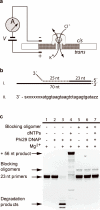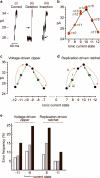Automated forward and reverse ratcheting of DNA in a nanopore at 5-Å precision
- PMID: 22334048
- PMCID: PMC3408072
- DOI: 10.1038/nbt.2147
Automated forward and reverse ratcheting of DNA in a nanopore at 5-Å precision
Abstract
An emerging DNA sequencing technique uses protein or solid-state pores to analyze individual strands as they are driven in single-file order past a nanoscale sensor. However, uncontrolled electrophoresis of DNA through these nanopores is too fast for accurate base reads. Here, we describe forward and reverse ratcheting of DNA templates through the α-hemolysin nanopore controlled by phi29 DNA polymerase without the need for active voltage control. DNA strands were ratcheted through the pore at median rates of 2.5-40 nucleotides per second and were examined at one nucleotide spatial precision in real time. Up to 500 molecules were processed at ∼130 molecules per hour through one pore. The probability of a registry error (an insertion or deletion) at individual positions during one pass along the template strand ranged from 10% to 24.5% without optimization. This strategy facilitates multiple reads of individual strands and is transferable to other nanopore devices for implementation of DNA sequence analysis.
Figures




Comment in
-
DNA sequencing with nanopores.Nat Biotechnol. 2012 Apr 10;30(4):326-8. doi: 10.1038/nbt.2181. Nat Biotechnol. 2012. PMID: 22491281 No abstract available.
-
A nanopore workhorse.Nat Methods. 2012 Apr;9(4):322-3. doi: 10.1038/nmeth.1962. Nat Methods. 2012. PMID: 22563599 No abstract available.
References
Publication types
MeSH terms
Substances
Grants and funding
LinkOut - more resources
Full Text Sources
Other Literature Sources
Miscellaneous

